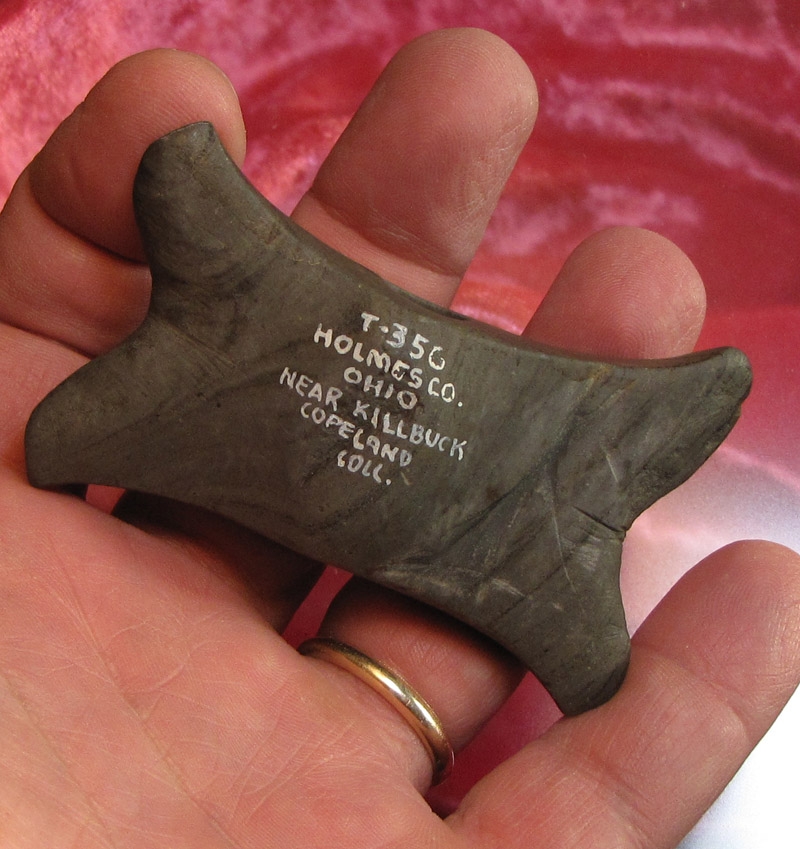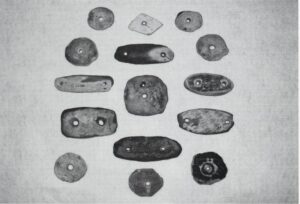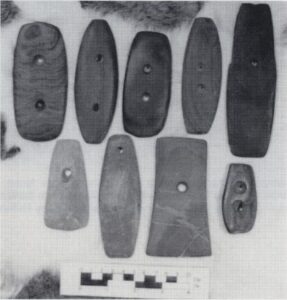The Differing Variations
by: Bill Koup
Albuquerque, New Mexico
The Butterfly or Winged bannerstone of banded slate is probably the most popular and sought after form of bannerstone among collectors. Few other bannerstones attract as much attention as a beautiful ultimate-design Butterfly banner. Certainly there are many other bannerstone forms of remarkable design or of exotic material that are by far more rare, but for the average collector these forms are largely unobtainable. But, when one looks over a medium to large general collection of artifacts from Kentucky to Canada or New York to Iowa one will generally find an example of a Winged bannerstone. Obtaining a nice example of these interesting and beautiful bannerstones is usually a collectiong goal of those who have an interest in slate artifacts.
All of the bannerstones discussed and illustrated in this article may be termed a Winged banner-stone and some would call all of them Butterflies. In Bannerstones of the North American Indian, Byron Knoblock grouped all of them into the Notched Butterfly group and differentiated them by class A, B or C. However, in most instances collectors usually refer to those bannerstones with notches as Butterfly bannerstones and those without notches as Winged bannerstones. Perhaps they should be called one name or the other since the only major distinction amoung most of them is either the presence or absence of notches. For the purposes of this article both the names Butterfly and Winged will be used.
The popularity of Butterfly and Winged bannerstones among collectors is due largely to two related reasons. Design and Availability. The prehistoric Archaic people who made these banners obviously were very attracted to the design of winged bannerstones. The original popularity of this design spread over a huge geographic area encompassing a large part of the entire bannerstone making area. The Archaic people who made these beautiful bannerstones were very satisfied with these designs. Significant is the fact that characteristics changed very little from one side of this range to the opposite. A double nottched butterfly bannerstone found in Canada or upstate New York can be nearly identical in design characteristics, size, and material to one found in southern Illinois or western Kentucky. The same could be said about other variations of winged banners. This high incidence of usage over a huge geographic area is certainly a primary reason for their popularity among collectors today. The form is very pleasing to behold and specimens are frequently available in many areas through trade with other collectors, artifact auctions or estate auctions.
From what has been stated above, one might get the idea that Butterfly/Winged bannertones are common. No bannerstone is common. However, among bannerstones, the winged varieties seem to be fairly plentiful, but most of them are not the classic ultimate-design specimens. Superb examples of any size are rare. Many winged banners have been rather crudely manufactured having either a thick unrefined appearance or being assymetrical or both. These are plentiful and easy to collect. Better examples in the small to average size range are less common but still routinely available. But top authentic examples of clasic thin-winged bannerstones of larger than average size are exceptionally rare. They have not survived the ages very well and there were fewer of them made. These large banners are very thin and fragile. Many of them were broken in prehistoric times. Many more were broken by farm machinery. Still others have been broken by unfortunate finders and collectors.
Following is a brief description of the seven winged bannerstones in this writer’s collection. Collecting a top example of all the variations of this type of bannerstone has been a real challenge that has taken years to accomplish. These examples are well above the average in size and quality. The accompanying photogtaphs to this article illustrate the opposite side and end views of the same banners that are shown in color elsewhere in this journal.
Left column, top. This is an undrilled butterfly bannerstone which may be the most unique type among all bannerstone. It is the only type manufactured specifically to not be perforated. Instead it has a rather wide and shallow groove on both sides in which to facilitate exterior hafting (see end view photo, bottom banner). This type of butterfly banner is found almost exclusively in the state of Michigan. However, a few are known to have been found in northern Indiana and northern Ohio. This bannerstone was found in Michigan and first collected by Arthur Abraham from Davison, Michigan. It is pictured in Who’s Who Number 2 as part of the Hubert Wachtel collection. It is made from red-brown banded slate and is 6 1/4 inches in width. It was later collected by Hugh Huff and Ron Ammerman.
Left column, bottom. Although this banner is not a particularly large or fine example of a double-notched butterfly banner, it is a good example of those that are made in a thicker, heavier style.This writer has noted several of this type as being from northeast Indiana. They are often very symmetrical and well made but they are thick in profile in comparison to the classic thin winged examples. This banner is from DeKalb County Indiana and has a width of 4-3/4 inches. It was found by Dennis Poorman on his farm near Waterloo. It was then purchased from Poorman by Cameron Parks in 1940.
Right column, top. This is another example of the classic double notched butterfly banner. It was found in Cass County Indiana and has two sharp central ridges (see end view photo, third from bottom) and very deeply cut notches that have been noted on other banners found in the same general area as this example. This bannerstone is 5 inches wide and made from dark green banded slate. The earliest known collector was H. C. Wachtel of Dayton, Ohio. Later collectors were John Berner and Hugh Huff.
Right column, bottom. This single notched butterfly bannerstone from Miami County, Ohio illustrates the variation that is probably the rarest of the winged bannerstones. It is 5-3/8 inches wide and made from green highly banded and contrasting slate. It also has sharp central ridges parallel to the perforation (see end view photo, third from the top). This bannerstone was originally collected by V. E. Ladd of Toledo, Ohio and later by Randal Jones
Another noteworthy observation on these seven bannerstones is the fact that four of them have significant white streaks or splotches in the material from which they were made. These particular pieces of slate were chosen for these banners due to the presence of these streaks. Many other very fine slate artifacts have been made from slate that contains these streaks.

Group of various forms of slate butterfly banners. Top row left to right, found near Angola, In., ex Archie Diller Collection, Pickaway Co., Ohio, from Stan Copeland. Middle row, left from five miles east of Kenton, Hardin Co., Ohio, ex Dana Baker Collection, right, provenience unknown, ex Bill Jenkins Collection. Bottom row, left, from Dekalb Co., In., ex Donald Boudeman and Cameron Parks Collections, pictured in Bannerstones of the North American Indian, pages 514 and 515, left a small example from Pickaway Co., Ohio, ex McKnight Brothers Collection. (Photograph by Charlie Wagers.)
Article used with permission by Bill Koup, Author
logical Society, click here:CSASI.org





